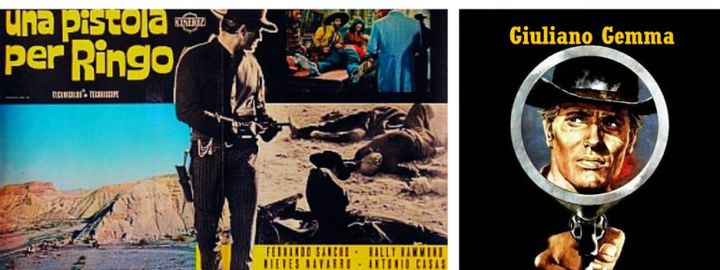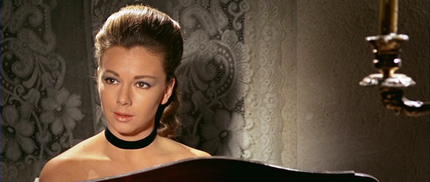A Pistol for Ringo Review: Difference between revisions
m (link) |
No edit summary |
||
| (38 intermediate revisions by 5 users not shown) | |||
| Line 1: | Line 1: | ||
<center> [[File:Ringowide.jpg|720px]] </center> | |||
<center> ''An essential spaghetti western from the early days of the genre. Giuliano Gemma is Ringo, a clean-shaven, well-dressed pistolero who interferes in a hostage situation. The action takes place on Christmas Eve'' </center> | |||
'''Director''': Duccio Tessari - '''Cast:''' Giuliano Gemma, Lorella de Luca, Fernando Sancho, Nieves Navarro, Antonio Casas, George Martin, José Manuel Martin, Pajarito - '''Music:''' Ennio Morricone | |||
<center> [[File:Trennlinie01.jpg|60px]] [[Pistola per Ringo, Una|See Database Page]] [[File:Trennlinie01.jpg|60px]] </center> | |||
In the first scene two people approach each other in the main street of a western town. Normally this means trouble, but ''A Pistol for Ringo'' is set in Christmas time, so Christmas greetings are exchanged. But we're in a spaghetti western, therefore this Christmas will not be a peaceful one. A gang of Mexicans have crossed the border and robbed the bank. While trying to get out of town, their leader, Sancho (played by Fernando), is hurt, and in an attempt to shake off their persecutors, the Mexicans take refuge in a nearby ranch and take the occupants hostage. The sheriff is reluctant to take action because his fiancée is among the hostages. The only one who can possibly help him, is the famous gunslinger Ringo, who shot four men out of self-defense, but was arrested nevertheless, and is now spending Christmas in jail. The sheriff promises to set Ringo free if he is willing to infiltrate the gang and find a way out of the status quo ... | |||
''A Pistol for Ringo'' was one of the most successful films of the early stream of spaghetti westerns. Director [[Duccio Tessari]] had been one of the co-authors of Leone's first western, '''''[[Per un pugno di dollari|A Fistful of Dollars]]''''' and Ringo is clearly modeled after the Man with No Name. But he's not a clone. Just look at the way the character is introduced: he's playing with a group of children when he is addressed by four guys. Before we know what is going on, he shoots all four of them. The wonderful scene says: ''I'm a cheerful fellow, but don't mess with me!'' A Pistol for Ringo was meant to be a lighter, less cynical version of the western Italian style, with [[Giuliano Gemma]] playing a character who is, so to speak, '''''No Name’s more fashionable brother''''': instead of a poncho, he's wearing a suit (modeled after the clothes Gary Cooper was wearing in ''High Noon''). His knickname would forever be '''''Angel Face'''''. | |||
[[ | ---- | ||
<center>[[File:Vlcsnap-2015-06-12-20h39m37s118.png|730px]] </center> | |||
---- | |||
A Pistol for Ringo was an important movie for the Italian film industry: it made a star out of former Italian stuntman Giuliano Gemma, and told the industry that a successful western could be made without an American import actor. It was also a breakthrough movie for both Sancho (who had previously appeared in Corbucci's ''[[Minnesota Clay]]'') and Navarro, resulting in a series of invitations for spaghetti westerns. Tessari had wanted Fernando Rey for the part of the old aristocrat, but when Rey turned out to be engaged, the Spanish co-producers pushed forward the name of Antonio Casas, a former soccer player for Atletico Madrid (and a notorious ladies' man). | |||
Tessari tells his story very effectively, with acute dialogue (you'll learn what made equally born men different) and interesting plot twists. The film even has an endearing and tragic love affair - not a common thing within the genre - between a female member of the gang (the gorgeous Nieves Navarro), and the much older aristocratic ranch owner (Casas). Only the ending is a bit silly, with Gemma using a bell to deviate his bullet in order to shoot Sancho, who would otherwise be out of reach. Many critics thought Tessari's film was closer to Hollywood than Cinecittà , and indeed a Hollywood movie (albeit not a western) served as inspiration for the script: William Wyler's '''''Desperate Hours''''' (1955), a gangster movie with Humphrey Bogart, about three convicts terrorizing a family in an American suburb. The name Ringo is of Hollywood origin too: both John Wayne (in ''Stagecoach'') and Gregory Peck (in ''The Gunfighter'') played a character with this name (2). Apparently Tessari had already proposed the name Ringo to Leone for A Fistful of Dollars, but Leone had rejected it, allegedly because he had read about the historical Johnny Ringo, a member of the Clanton gang (1). | |||
A Pistol for Ringo | ''A Pistol for Ringo'' is not ''too'' violent, but the body count is pretty high and there’s at least one outrageous scene with Sancho executing Mexican peons, that would inspire Sergio Corbucci to a similar (if more sadistic) scene in Django. The film’s success led to a '''''sequel''''', '''''[[Ritorno di Ringo, Il|Return of Ringo]]''''', made by the same director, shot on virtually the same locations, and starring the same group of actors, but telling a quite different story (Italian sequels often are no sequels at all!). The Spanish locations don’t look very American (never knew there were so many windmills in Texas) but the photography is breathtaking and both the indoor and outdoor scenes are shot inventively. Morricone's score is, needless to say, very fine. Maurizio Graf sings the title song (lyrics by Gino Paoli): ''"Ringo had an Angel Face, but whenever Ringo loved, Ringo fought"''. However, some of the lyrics, seem more appropriate for the film's sequel ''Return of Ringo'' : ''"(...) and the woman who's waiting for his return"''. There's no woman waiting for Ringo to return in this one. | ||
'''''Notes:''''' | |||
* (1) Marco Giusti, [[Dizionario Del Western All'Italiana]] | |||
* (2) Some have linked the name to ''the song'' Ringo, sung by Lorne 'Bonanza' Greene, that was translated in Italian for Adriano Celentano and a hit in Italy in both versions. | |||
<center> [[File:Trennlinie01.jpg|130px]] </center> | |||
<center>[[File:Vlcsnap-2015-06-12-14h03m45s199.png|430px]] [[File:Vlcsnap-2015-06-12-19h00m00s25.png|430px]]</center> | |||
<div style="border:1px solid #AAAAAA; padding:2px; margin:0px; font-size: 90%; font-weight:bold; text-indent:0.5em;">'''A Pistol for Ringo''' (1965) | [[The Return of Ringo Review (Scherpschutter)|The Return of Ringo]] (1965)</div> | |||
{{SimonSignature}} | |||
[[Category:Reviews]] | [[Category:Reviews]] | ||
[[Category:Duccio Tessari]] | |||
[[Category:Giuliano Gemma]] | |||
[[Category:Fernando Sancho]] | |||
[[Category:Nieves Navarro]] | |||
[[Category:Antonio Casas]] | |||
Latest revision as of 20:44, 29 August 2019

Director: Duccio Tessari - Cast: Giuliano Gemma, Lorella de Luca, Fernando Sancho, Nieves Navarro, Antonio Casas, George Martin, José Manuel Martin, Pajarito - Music: Ennio Morricone
In the first scene two people approach each other in the main street of a western town. Normally this means trouble, but A Pistol for Ringo is set in Christmas time, so Christmas greetings are exchanged. But we're in a spaghetti western, therefore this Christmas will not be a peaceful one. A gang of Mexicans have crossed the border and robbed the bank. While trying to get out of town, their leader, Sancho (played by Fernando), is hurt, and in an attempt to shake off their persecutors, the Mexicans take refuge in a nearby ranch and take the occupants hostage. The sheriff is reluctant to take action because his fiancée is among the hostages. The only one who can possibly help him, is the famous gunslinger Ringo, who shot four men out of self-defense, but was arrested nevertheless, and is now spending Christmas in jail. The sheriff promises to set Ringo free if he is willing to infiltrate the gang and find a way out of the status quo ...
A Pistol for Ringo was one of the most successful films of the early stream of spaghetti westerns. Director Duccio Tessari had been one of the co-authors of Leone's first western, A Fistful of Dollars and Ringo is clearly modeled after the Man with No Name. But he's not a clone. Just look at the way the character is introduced: he's playing with a group of children when he is addressed by four guys. Before we know what is going on, he shoots all four of them. The wonderful scene says: I'm a cheerful fellow, but don't mess with me! A Pistol for Ringo was meant to be a lighter, less cynical version of the western Italian style, with Giuliano Gemma playing a character who is, so to speak, No Name’s more fashionable brother: instead of a poncho, he's wearing a suit (modeled after the clothes Gary Cooper was wearing in High Noon). His knickname would forever be Angel Face.

A Pistol for Ringo was an important movie for the Italian film industry: it made a star out of former Italian stuntman Giuliano Gemma, and told the industry that a successful western could be made without an American import actor. It was also a breakthrough movie for both Sancho (who had previously appeared in Corbucci's Minnesota Clay) and Navarro, resulting in a series of invitations for spaghetti westerns. Tessari had wanted Fernando Rey for the part of the old aristocrat, but when Rey turned out to be engaged, the Spanish co-producers pushed forward the name of Antonio Casas, a former soccer player for Atletico Madrid (and a notorious ladies' man).
Tessari tells his story very effectively, with acute dialogue (you'll learn what made equally born men different) and interesting plot twists. The film even has an endearing and tragic love affair - not a common thing within the genre - between a female member of the gang (the gorgeous Nieves Navarro), and the much older aristocratic ranch owner (Casas). Only the ending is a bit silly, with Gemma using a bell to deviate his bullet in order to shoot Sancho, who would otherwise be out of reach. Many critics thought Tessari's film was closer to Hollywood than Cinecittà , and indeed a Hollywood movie (albeit not a western) served as inspiration for the script: William Wyler's Desperate Hours (1955), a gangster movie with Humphrey Bogart, about three convicts terrorizing a family in an American suburb. The name Ringo is of Hollywood origin too: both John Wayne (in Stagecoach) and Gregory Peck (in The Gunfighter) played a character with this name (2). Apparently Tessari had already proposed the name Ringo to Leone for A Fistful of Dollars, but Leone had rejected it, allegedly because he had read about the historical Johnny Ringo, a member of the Clanton gang (1).
A Pistol for Ringo is not too violent, but the body count is pretty high and there’s at least one outrageous scene with Sancho executing Mexican peons, that would inspire Sergio Corbucci to a similar (if more sadistic) scene in Django. The film’s success led to a sequel, Return of Ringo, made by the same director, shot on virtually the same locations, and starring the same group of actors, but telling a quite different story (Italian sequels often are no sequels at all!). The Spanish locations don’t look very American (never knew there were so many windmills in Texas) but the photography is breathtaking and both the indoor and outdoor scenes are shot inventively. Morricone's score is, needless to say, very fine. Maurizio Graf sings the title song (lyrics by Gino Paoli): "Ringo had an Angel Face, but whenever Ringo loved, Ringo fought". However, some of the lyrics, seem more appropriate for the film's sequel Return of Ringo : "(...) and the woman who's waiting for his return". There's no woman waiting for Ringo to return in this one.
Notes:
- (1) Marco Giusti, Dizionario Del Western All'Italiana
- (2) Some have linked the name to the song Ringo, sung by Lorne 'Bonanza' Greene, that was translated in Italian for Adriano Celentano and a hit in Italy in both versions.






